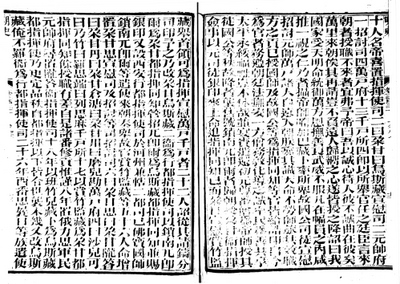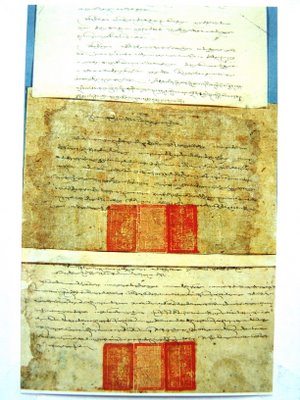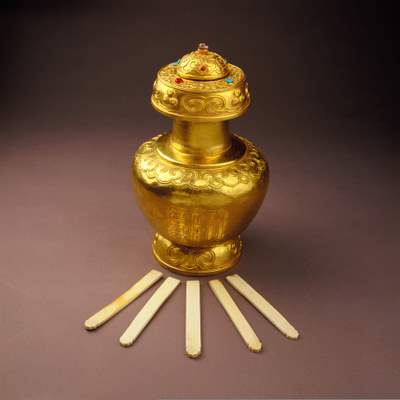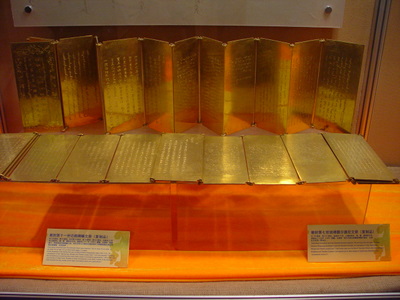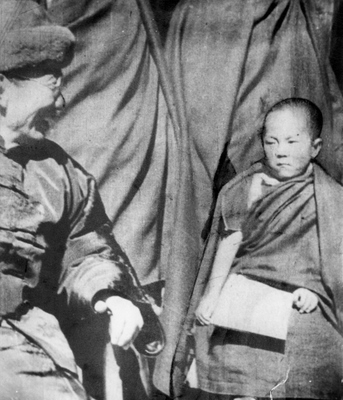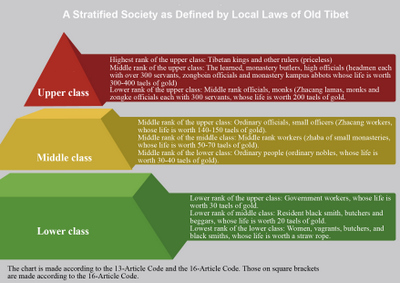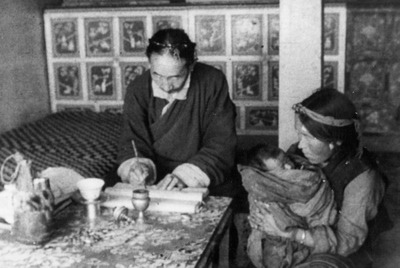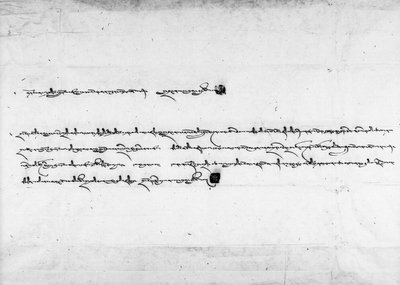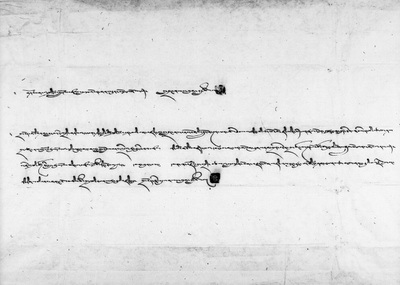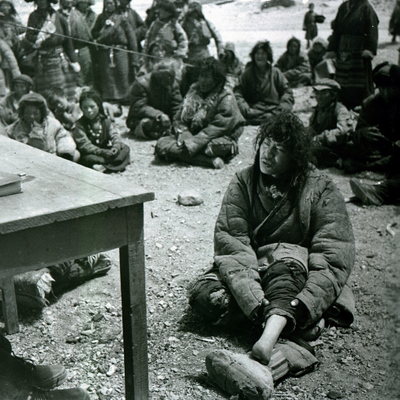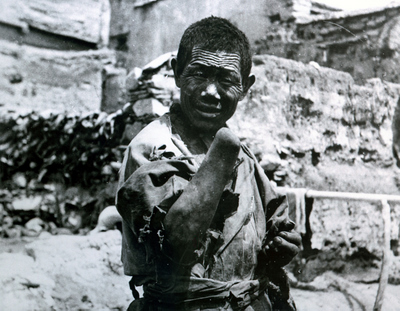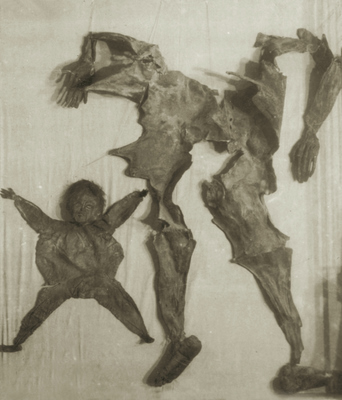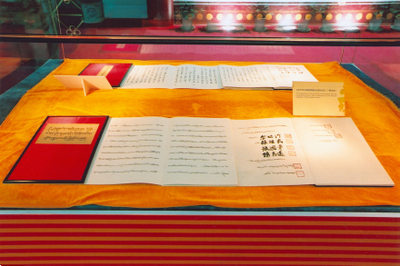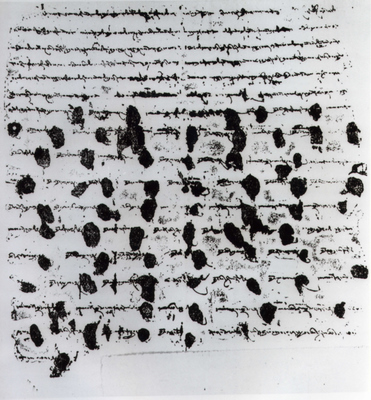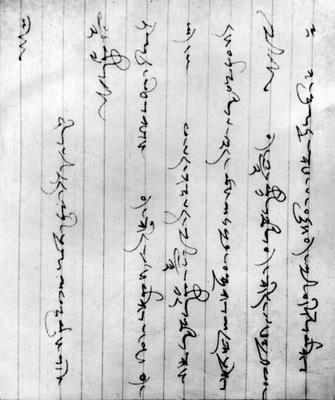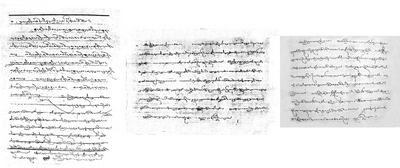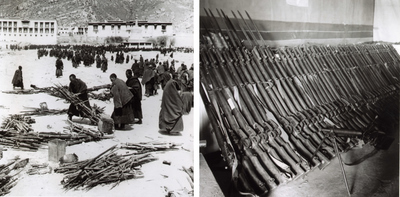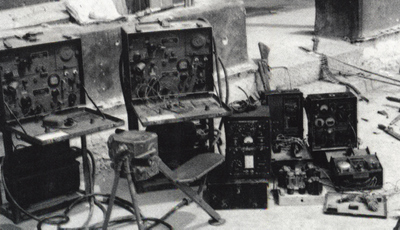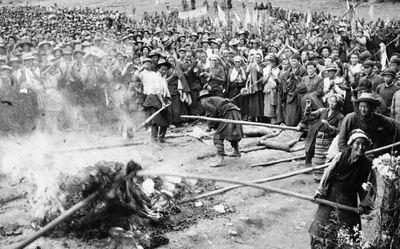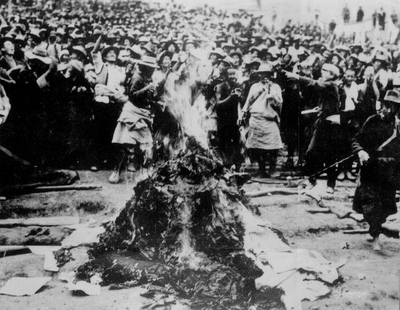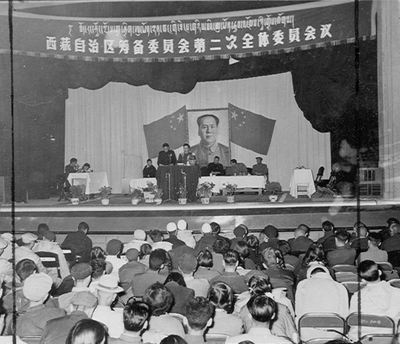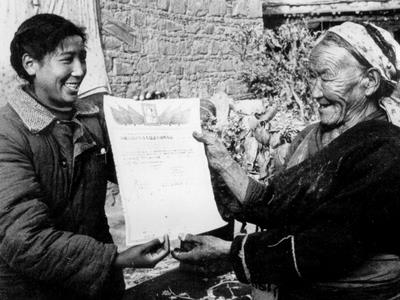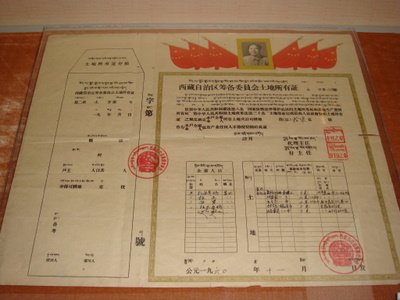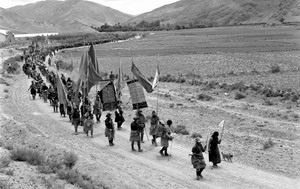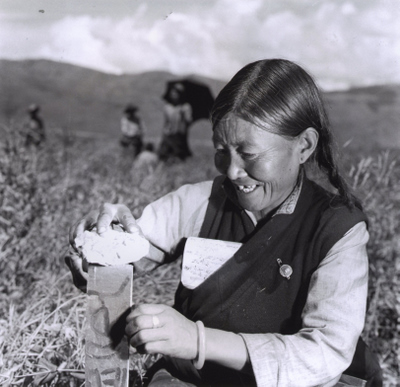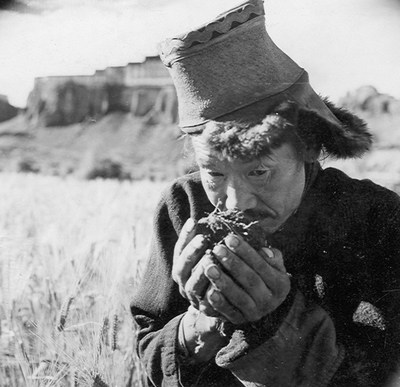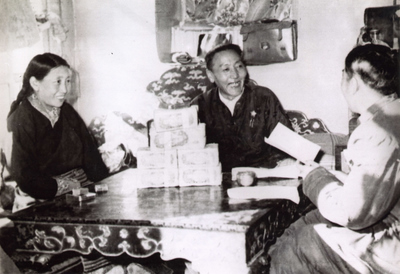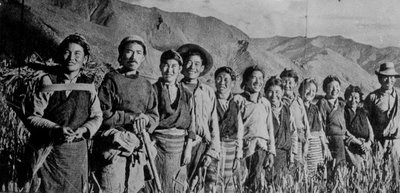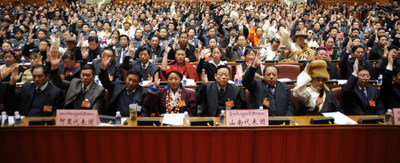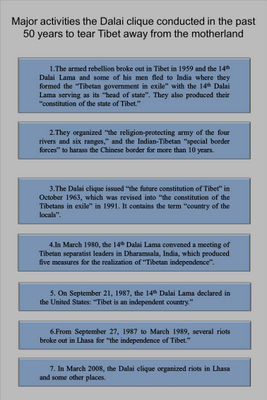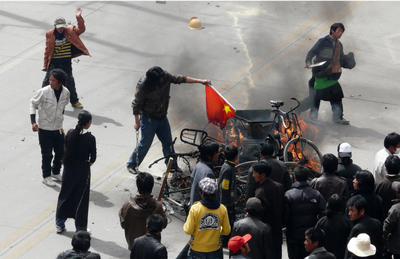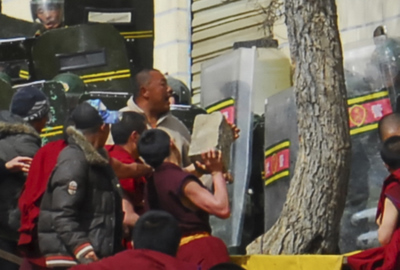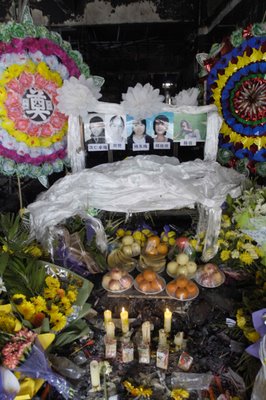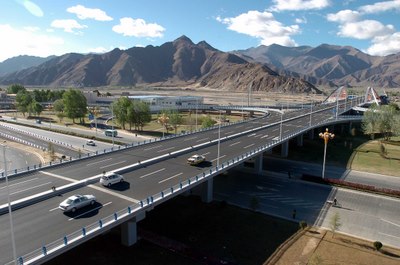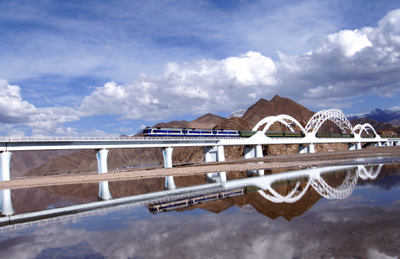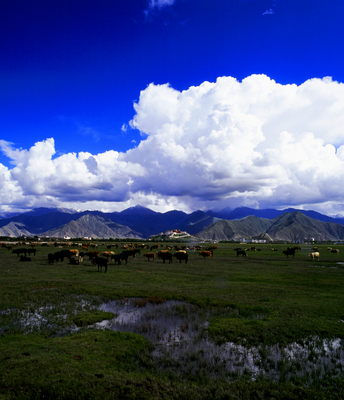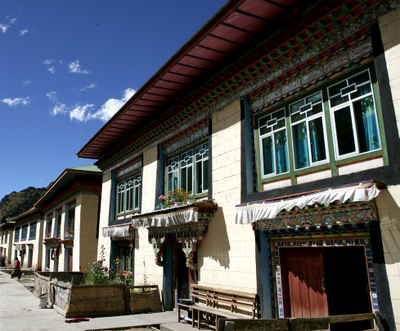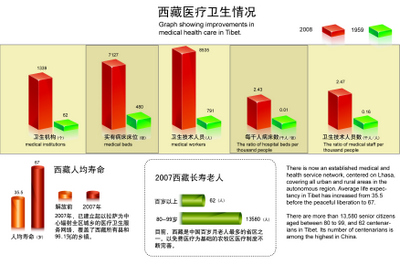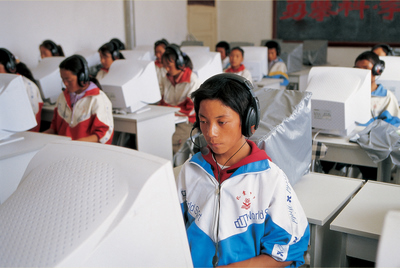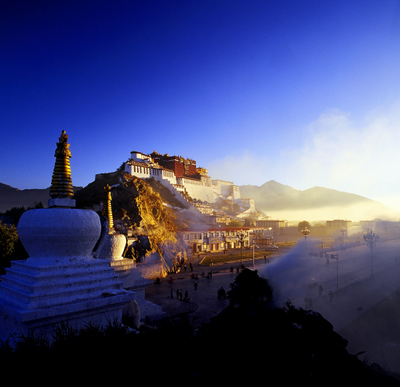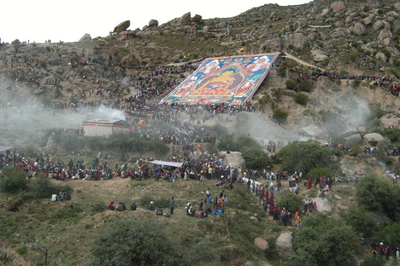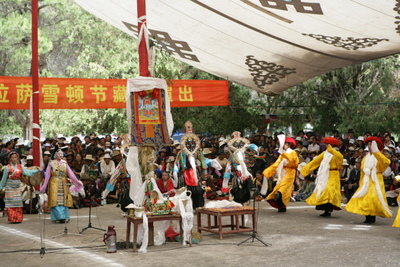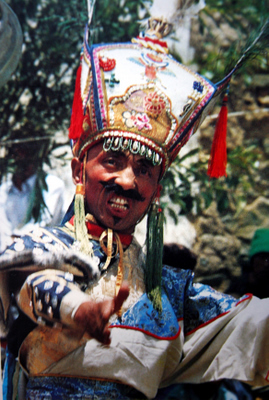| '50 Years of Democratic Reform in Tibet' photo exhibition | ||||||||||||||||||||||||||||||||||||||||||||||||||||||||||||||||||||||||||
| 2009-03-22 18:56 | ||||||||||||||||||||||||||||||||||||||||||||||||||||||||||||||||||||||||||
|
Preface
Tibet, located in southwest China, has since the ancient times been an inalienable part of China. Before the Democratic Reform in 1959, Tibet had long been a society of feudal serfdom featuring the despotic temporal and religious administration, a society which was darker and more cruel than the European serfdom of the Middle Ages. The People's Republic of China was founded in 1949, and in 1951, Tibet won peaceful liberation. The Central Government was prudent with regard to the reform of the social system of old Tibet and adopted a tolerant attitude toward the local government of Tibet. With great patience and sincerity, the Central Government did its best to talk to the upper ruling class in Tibet and waited for it to conduct reform of the old system of its own accord. However, the reactionary clique of the upper social strata of Tibet tried to preserve for ever the feudal serfdom featuring temporal and religious administration, and in March 1959 launched an armed rebellion with the aim of tearing Tibet away from the motherland. The Central Government, with the support of the people in Tibet, dissolved the local government of Tibet which rode roughshod over the broad masses of the Tibetans and resolutely suppressed the armed rebellion. At this same time, the Central Government, responding to the will of the Tibetan people, implemented the Democratic Reform and abolished the feudal serf system featuring temporal and religious administration that had lasted for several centuries. During the Democratic Reform, one million serfs and slaves in Tibet won emancipation, Tibet entered into a new era of social development, and the Tibetan people stood up and came into their own. In order to mark this historic event, the People's Congress of the Tibet Autonomous Region decided on January 19, 2009 that March 28, the day in 1959 the Central Government ordered the disorganization of the local government of old Tibet, be the "Serf Emancipation Day" of Tibet. To mark the 50th anniversary of the Democratic Reform in Tibet, this photo exhibition is held to show its great cause and the changes that have taken place to Tibet over the past 50 years; it is also aimed at helping the international community gain a better understanding of the history and present situation of Tibet. Part I: Tibet-An Inseparable Part of China China is a unified country made up of 56 ethnic groups, Tibetan included. During the Tang Dynasty (618-907), Tibet and the Tang Dynasty had, through marriage between royal families and meetings leading to alliances, cemented political and kinship ties of unity and political friendship and formed close political, economic and cultural relations. In 1271, when the Yuan Dynasty (1271-1368) was founded, Tibet officially became an administrative region directly under the jurisdiction of the Central Government. In the ensuing centuries, although China experienced the Ming Dynasty (1368-1644), Qing Dynasty (1644-1911) and the Republic of China (1912-1949), Tibet remained under the effective rule of the Central Government.
Photo 1-1
Picture shows Norbu Lingka mural Princess Wencheng Entering Tibet. Early in the 7th century, the Tang Dynasty (618-907) was founded in the Central Plains. It was a powerful and politically united regime that initially established order over the shifting and chaotic situation that had prevailed for more than 300 years in the Central Plains. At the same time, the Tubo leader Songtsan Gambo brought together tribes on the Tibet Plateau, established the Tubo Kingdom covering a large part of what later became known as Tibet. In 640, Tubo King Songtsan Gambo sent his "prime minister" Gar Tongtsan to the Tang court in Chang'an, capital of the Tang Dynasty, requesting a member of the imperial family be given to him in marriage. Gar Tongtsan brought 5,000 tales of gold and hundreds of jewels and other precious stones as gifts to the Tang emperor. Princess Wencheng, a member of Emperor Taizong's family, was sent to Tubo. She lived in Tubo for more than 40 years. During the period, outstanding culture and advanced production technology of the Tang Dynasty were brought to Tubo, a boon for Tubo's economic and cultural development. When Princess Wencheng told Songtsan Gambo the importance of a written language for Tubo, the Tubo King organized people to create 30 Tibetan scripts and work out grammars for the making of sentences. This put an end to the history in which Tubo had no written language. The Han Chinese works Princess Wencheng brought to Tubo were therefore translated into Tibetan, including those on poems, farming, history, medicine, calendaring and Buddhism. Tubo people gradually mastered the advanced technology of the Central Plains, such as cereals milling, cotton spinning and weaving, pottery-making, paper-making, and winery. As Princess Wencheng worshipped Buddhism, Songtsan Gambo supported the spread of Buddhism in Tubo and had the Jokhang Monastery built for this purpose. This exerted great influence on the spiritual life of the Tibetans. The statues of Princess Wencheng and Songtsan Gambo are still worshipped in the Potala Palace, and the site of their bridal chamber still visited. The Tibetans also sing songs to laud the role Princess Wencheng played to Tibet's economic and cultural development.
Picture shows the History of the Yuan Dynasty, which records the Central Government's establishment of the Xuanzheng Council. In 1271, Kublai Khan of the Mongols set Yuan as the name of his dynasty, with Dbus-Gtsang (present-day central and west Tibet, and its western area) and Mdo-khams as part of the Yuan Dynasty. Tibet was officially put under the rule of the Central Government. When the Yuan unified the whole of China, the Yuan court adopted a series of measures for the effective governing of Tibet in the light of its actual situation: ---Establishing the Zongzhi Council (renamed Xuanzheng Council in 1288) in charge of Buddhist affairs in the entire nation as well as local military and administrative affairs in Tibet and other regions. The Xuanzheng Council was in charge of officials and held generally by the prime minister, with its deputy chief being monk recommended by the Imperial Tutor. ---Conducting household surveys, setting up post stations, collecting taxes, stationing troops, appointing officials, and issuing Yuan criminal law and calendaring in Tibet. ---Appointing Tibetan monk and lay high officials at the regional and central levels. Administrative organs in Dbus-Gtsang and Mdo-khams were set up, and officials were appointed or dismissed or awarded at the order of the Central Government. ---Deciding on the administrative division in Tibet. The Yuan court set up three separate Pacification Commissioners in Tibet, who were put directly under the Xuanzheng Council. This finds its way into the Tibetan history books, and this administrative division in Tibet becomes the foundation for the ensuing political powers to make administrative division in Tibet.
Photo 1-3 Picture shows History of the Ming Dynasty on the administrative and military organs of Tibet. The Ming Dynasty (1368-1644) which replaced the Yuan Dynasty to rule China basically followed the Yuan system in rule over Tibet. It had organs to take charge of the military and administrative affairs of the Lhasa and Xigaze areas, Qamdo and Ngari regions. Zongboin (equivalent to county magistrate) and officials at higher levels were all appointed by the Ming court.
Photo 1-4 Picture shows token of the High Commissioners. In 1644, the Qing (1644-1911) court decided to move its capital to Beijing for ensuing unification of the whole of China. Following the historical precedence, the Qing court exercised jurisdiction over Tibet. In 1652, the 5th Dalai Lama of the Gelug Sect of Tibetan Buddhism was summoned to Beijing for an audience with Qing Emperor Shunzhi and received honorific title "Dalai Lama" from the Qing court in the following year. Later on, the 5th Panchen Erdeni also received honorific title "Panchen Erdeni" from Qing Emperor Kangxi. The honorific titles of the Dalai Lama and the Panchen Erdeni and their political and religious role were officially confirmed. From then on, the Dalai Lama and the Panchen Erdeni of the ensuing generations have to be confirmed and given the honorific title from the Central Government and this has become a historical precedence. On the basis of summing up the experience of the Yuan and Ming Dynasties in rule over Tibet, the Qing court made substantial adjustment in the light of the actual situation of Tibet, such as appointing the High Commissioners to take charge of the work in Tibet; readjusting the political and administrative management system of Tibet; giving honorific titles to the Dalai Lama and the Panchen Erdeni and introducing the system of drawing a lot from the golden urn to confirm their soul boys; deciding that the decision-making power with regard to Tibet's foreign affairs and border defense belongs to the Central Government; demarcating Tibet's border with Qinghai, Sichuan and Yunnan; stipulating the areas ruled and power enjoyed by the Dalai Lama and the Panchen Erdeni respectively; and stipulating the area directly under the High Commissioners. The High Commissioners supervised the affairs in Tibet on behalf of the Central Government, and they enjoyed an official position the same as the Dalai Lama and the Panchen Erdeni.
Photo 1-5 Picture shows the Ordnance for the Effective Governing of Tibet In 1793 or the 58th year of the reign of Emperor Qianlong, the Qing court issued the Ordnance which contained clear stipulations on the religious affairs, administration, finance, military affairs and foreign affairs. Of its 29 articles, the first article stated that the soul boy of the Dalai Lama or the Panchen Erdeni has to be determined through the use of the method of drawing a lot from the golden urn.
Photo 1-6 Picture shows the golden urn. In 1792 or the 57th year of the reign of Emperor Qianlong, the Qing emperor had two golden urns made for the lot-drawing purpose. They were respectively sent to the Jokhang Monastery in Lhasa and the Yonghegong Lamasery in Beijing. Each of them stands 34 cm high, and is complete with five ivory lots. In history, various sects of Tibetan Buddhism all had their own succession methods to reinforce their positions and defend their vested political and religious rights and interests. This Living Buddha reincarnation system is unique to Tibetan Buddhism. According to historical records in Chinese and Tibetan, during the Qing Dynasty, apart from the Dalai Lama and the Panchen Erdeni reincarnation systems, there were also others. During the period of Qing Emperor Qianlong, 148 Hutogtu Living Buddhas were registered with and confirmed by the Department in Charge of Mongolian and Tibetan Affairs; and the number increased to 160 toward the end of the Qing Dynasty (1644-1911). At the end of the period of Emperor Qianlong, the Qing Government further reformed the administrative management system of Tibet by strengthening management over grand lamas. A series of methods were introduced for the reincarnation of the Grand Lamas, including the one of drawing a lot from the golden urn to determine the soul boy.
Photo 1-7 Goden sheet of authorization issued by Qing Emperor Daoguang to the 11th Dalai Lama in 1839.
Photo 1-8 Picture shows Wu Zhongxin, special envoy of the Central Government, was sent to visit the soul boy of the 13th Dalai Lama before he was later enthroned as the 14th Dalai Lama. In 1911, a revolution took place in China, overthrowing the rule of the Qing Dynasty. When the Republic of China (1912-1949) was founded in 1912, it promulgated its first constitution--the Provisional Constitution, which clearly stipulated that Tibet was one of its 22 provinces. The Constitution and other laws promulgated thereafter all stipulated that Tibet was part of the Republic of China. In July 1912, the Central Government set up the Bureau of Mongolian and Tibetan Affairs (renamed Mongolian and Tibetan Council in May 1914) to take charge of Tibetan local affairs. Its officials appointed by the Central Government worked directly under the premier in a way the Qing High Commissioners did during the Qing Dynasty. In 1929, the Mongolian and Tibetan Council became the Commission for Mongolian and Tibetan Affairs which, in April 1940, set up its Tibet Office in Lhasa. The 14th Dalai Lama himself was confirmed and enthroned all with the approval of the Central Government of the Republic of China. Great number of archives left behind from the period of the Republic of China show the 14th Dalai Lama, the local government of Tibet and the 10th Panchen Erdeni all had representatives in the National Congress, the supreme power organ, national government institutions; many of them were elected or appointed officials of the national authorities. Part II: Feudal Serfdom Featuring Temporal and Religious Administration Before the Democratic Reform in 1959, Tibet had long been a society of feudal serfdom featuring the despotic temporal and religious administration. As the head of the Gelug Sect of Tibetan Buddhism, the 14th Dalai Lama served as the head of the local government of Tibet, holding both the political and religious power at the same time. He is therefore the chief representative of this feudal serfdom. Tibet's three major estate-holders--local administrative officials, nobles and upper-ranking lamas in monasteries, and their agents, accounted for less than 5 percent of Tibet's population, but owned most of Tibet's means of production. However, serfs and slaves, who made up over 95 percent of Tibet's population, owned no means of production and enjoyed no personal freedom. Serf-owners had a firm grip on the birth, death and marriage of serfs and slaves. They could freely sell and buy, and transfer slaves and serfs, and could also exchange slaves and serfs with other slave-owners, and pay a debt with slaves and serfs. Serf-owners and major monasteries in Tibet established prisons of their own, and tortured inmates in a savage way. Statistics show, before 1959, the clan of the 14th Dalai Lama owned 27 manors, 30 pastures and some 6,000 slaves and serfs to till the land and herd livestock for them. The 13-Article Code and 16-Article Code, which were enforced in old Tibet, divided hgbfvdeswabody, while the lives of people of the lowest rank of the lower class are worth a straw rope.
Photo 2-1-E In the picture is a statistical table on the properties of the 14th Dalai Lama and his clan. Before 1959 Tibet followed the feudal serfdom featuring temporal and religious administration. The society was tightly controlled by the high-ranking monk and lay officials, and the slave-owners (officials, high lamas and nobles). The Dalai Lama was religious leader and also the largest slave-owner. Before the Democratic Reform in 1959, he and his clan owned 27 manors, 30 pastures and some 6,000 slaves and serfs. Each year, they collected 33,000 ke (each ke equal to 14 kg) of qingke highland barley, some 2,500 ke of butter, 300 head of cows and sheep, 175 rolls of pulu woolen fabrics, and more than 2 million tales of Tibetan silver from their slaves and serfs engaged in farming and livestock breeding. And the Dalai Lama himself alone owned some 10,000 pieces of silk, high-grade woolen and fur garments, including some 100 cloaks adorned with gems and other precious stones. Up till 1959, he owned more than 160,000 tales of gold, 95 million tales of silver and more than 20,000 pieces of jewelry.
Photo 2-2-E Picture shows the exploitation of serfs and slaves in a manor. Before the Democratic Reform in 1959, Tibet had long been a society of feudal serfdom featuring the despotic temporal and religious administration, a society which was darker and more cruel than the European serfdom of the Middle Ages. Statistics show Tibet's three major estate-holders--officials, nobles and upper-ranking lamas in monasteries, and their agents, accounted for less than 5 percent of Tibet's population, but owned most of Tibet's means of production. The three major monasteries (the Sera, Gandain and Zhaibung Monasteries) in Lhasa, for instance, owned 321 manors, 147,000 ke (15 ke equal to one hectare) of land, 26 pastures and some 40,000 slaves and serfs.
Photo 2-3-E
Picture tells the legal codes of old Tibet divided the Tibetans into three classes and nine ranks. In order to safeguard the interests of serf-owners, Tibetan local rulers formulated a series of laws. The 13-Article Code and the 16-Article Code, which were enforced in old Tibet for several hundred years, divided people into three classes and nine ranks. They clearly stipulated that people were unequal in legal status. The standards for measuring punishment and the methods for dealing with people of different classes and ranks who violated the same criminal law were quite different. In the law concerning the penalty for murder, it was written, "As people are divided into different classes and ranks, the value of a life correspondingly differs." The lives of people of the highest rank of the upper class, such as a prince or Grand Living Buddha, are calculated in gold to the same weight as the dead body. The lives of people of the lowest rank of the lower class, such as women, butchers, hunters and craftsmen, are worth a straw rope. Under the rampart of the institutionalized rigid hierarchy, the inequality between the rulers and the ruled people and between the exploiters and exploitees was further strengthened in terms of the economic and political status. Moreover, this kind of inequality was even showed in every detail of daily life and a noun or a verb in the speech.
Photo 2-4 Picture shows serf holding the newborn baby went to pay tax to and get the baby registered with the serf-owner. In old Tibet which followed the feudal serfdom featuring temporal and religious administration, the three estate-holders owned most of the means of production and, through economic means, owned slaves and serfs. Gashag, the local government of Tibet, stipulated that serfs were not allowed to leave at will the manors they belonged to; they were banned to flee. Serfs and slaves, making up 95 percent of the Tibetan population, were attached to land and subject to the three estate-holders. They enjoyed no personal freedom at all. Serf-owners had a firm grip on the birth, death and marriage of serfs. They could freely sell and buy, and transfer slaves and serfs, and could also exchange slaves and serfs with other slave-owners, and pay a debt with slaves and serfs. Children of serfs were registered the moment they were born, setting their life-long fate as serfs. After death, the names of serfs were written off from the book held by their owners. Male and female serfs not belonging to the same owner had to pay "redemption fees" before they could marry. Newborn babies of serfs had to pay "birth tax" and got registered with the owners their parents belonged to; this means they would be lifelong serfs of the owners in future too. When serfs were forced to make a living in other places, they had to pay tax; they would not be taken as the fugitive only when they could show paper certifying they had paid tax for this. This fully shows the serfs enjoyed no personal freedom at all, let alone dignity.
Photo 2-5 Picture shows the serf carrying his serf owner, a kind of Ula corvee. Serf-owners ruthlessly exploited serfs through corvee and usury. Incomplete statistics indicate the existence of more than 200 categories of corvee taxes levied by the Gaxag (Tibetan local government). The corvee assigned by Gaxag and manorial lords accounted for over 50 percent of the labor of serf households, and could go as high as 70-80 percent. Ula corvee is the principal form in which the three major estate-holders ruthlessly exploited the serfs in old Tibet under feudal serfdom. Ula corvee is a general term for various corvee, taxes and ground rent in a broad sense. These corvee labor and taxes brought serfs heavy burden. Despite industrious labor year after year and month after month, they had no enough food to live on. Permanent corvee tax was registered and there were also temporary additional corvee taxes. The corvee tax was divided into "inside" and "outside" ones in form. The former refers to various forced labor and materials that serfs should pay to the aristocrats, or upper-ranking monks, and monasteries and their agents. The three major estate-holders could levy corvee and taxes on their serfs at will as long as they needed. There was no explicit provision as to how many corvee taxes the serfs would pay, which was determined by the estate-holders. In this way, serfs spent two-thirds, even three-fourths time of a year offering free corvee labor for their estate-holders. The "outside" one refers to the corvee and taxes that serfs paid to the Gaxag (Tibetan local government). Serfs needed to carry the officials, monks, businessmen and soldiers holding the tokens given by the Gaxag, and their materials free with man power or animal power, lodge them free, construct some projects launched by the Gaxag and monasteries free, and pay some materials such as highland barley, butter and eggs and money such as silver dollars and Tibetan silver that the Gaxag needed.
Photo 2-6 Picture shows serf-owners forced their serfs to do labor while being shackled. In old Tibet, the level of the productive forces was very low, the farm tools were primitive with wooden plow, wooden hoe or iron-plowshare wooden plough still used in main agricultural areas, and grain yield was only four to five times the seeds sown.
Photo 2-7 Picture shows a nangzan serf named Cering Zholma living under a toilet. Serfs made up 90 percent of old Tibet's population. They were called tralpa in Tibetan (namely people who tilled plots of land assigned to them and had to provide corvee labor for the serf-owners) and duiqoin (small households with chimneys emitting smoke). They had no land or personal freedom, and the survival of each of them depended on an estate-holder's manor. In addition, nangzan who comprised 5 percent of the population were hereditary household slaves, deprived of any means of production and personal freedom. Nangzan means "domesticated" slaveries. They were viewed as the "speaking beast" by the serf-owners.
Photo 2-8 Picture shows a stamped official document about monastery "Lharang" sending serfs Cering Dorje, Kumsang (female), and Sumpotri (female) to the Chawo residence palace as servants. Serf-owners literally possessed the living bodies of their serfs. Since serfs were at their disposal as their private property, they could trade and transfer them, present them as gifts, make them mortgages for a debt and exchange them. According to historical records, in 1943 the aristocrat Chengmoim Norbu Wanggyai sold 100 serfs to a monk official at Garzhol Kamsa, in Zhikung area, at the cost of 60 taels of Tibetan silver (about four silver dollars) per serf. He also sent 400 serfs to the Gundeling Monastery as mortgage for a debt of 3,000 pin Tibetan silver (about 10,000 silver dollars).
Photo 2- 9 Picture shows a slum called Pangcun in Lhasa, which was home to beggars. Before the Democratic Reform in Tibet in 1959, Lhasa's downtown area had a population of some 20,000. It was surrounded by some 1,000 tattered tents, homes of poverty-stricken people and beggars. The average life expectancy was only 35.5 years in old Tibet in 1951. In old Tibet there was not a single school in the modern sense. The enrollment rate of school-age children was less than 2 percent, and the illiteracy rate reached 95 percent.
Photo 2-10 In the picture, one foot of a herder named Duito in Amdo County was chopped off by the tribal chief. The interests of the three major estate-holders were sacred and inviolable in the codes. If the serfs encroached upon the interests of the three major estate-holders, it was regulated in the codes that "such punishments as gouging out the eyes, paring the leg meat, cutting off tongue and hands, pushing people from the cliff, throwing people into water or killing the person would be conducted to the violators in accordance with the different offence as a warning to others". However, the rights and interests of the broad masses of serfs and slaves were not at all guaranteed in the codes; and it was illegal for the serfs and slaves to cry out their grievances. The codes stipulated, "Anyone who voices grievances at the palace, behaving disgracefully, should be arrested and whipped"; "anyone who resists a master's control should be arrested"; "anyone who spied the important matter should be arrested"; and "a commoner who offends an official should be arrested". It was also stipulated that a servant who seriously injured his master should have his hands or feet chopped off; a master who injured a servant was only responsible for the medical treatment for the wound, with no other compensation required. The one who injured a Living Buddha committed a felony and should have eyes gouged out, feet and hands chopped off or be executed in various ways. It was just these appalling stipulations that made the three major manorial lords conduct varied atrocities on the serfs and slaves at their pleasure.
Photo 2-11 Picture shows herder Pemo Hongchin shoes right hand was chopped off by the serf-owner. Making use of written or common law, the serf-owners set up private jails. Local governments had law courts and prisons, as had large monasteries. Estate-holders could build private prisons on their own manor ground. Punishments were extremely savage and cruel, and included gouging out the eyes; cutting off ears, hands and feet; pulling out tendons; and throwing people into water. Many materials and photos showing limbs of serfs mutilated by serf-owners in those years are kept in the Tibetan Social and Historical Relics Exhibition in the Beijing Ethnic Cultural Palace.
Photo 2-12 Picture shows the skins of people decorticated by a serf-owner. The monasteries formulated special "regulations" and the nobles the detailed "domestic laws" in their own manors according to the codes. Both the monasteries and nobles could use instruments of torture and set up law courts privately to punish the serfs and slaves and even put them to death. The late 10th Panchen Erdeni said when he received the interview of a reporter from the magazine National Unity, "Before the Democratic Reform in 1959 Tibet had long been a society of feudal serfdom under the despotic religion-political rule of lamas and nobles, a society which was darker and more cruel than the European serfdom of the Middle Ages." In the Gandain Monastery, one of the largest in Tibet, there were many handcuffs, fetters, clubs and other cruel instruments of torture used for gouging out eyes and ripping out tendons. A letter to Rabodian chief in the early 1950s kept in the Tibet Autonomous Region Archive bore witness to this. It said, "In order to celebrate the birthday of the Dalai Lama, all the members of the Lower Tantric Institute should chant the script. To practically complete this Buddhist service, one wet intestine, two skulls, various kinds of blood and a whole piece of the skin of a person are required urgently. You'd better bring them here as soon as possible." Part III: Democratic Reform in Tibet The Agreement of the Central People's Government and the Local Government of Tibet on Measures for the Peaceful Liberation of Tibet (the 17-Article Agreement) signed in 1951 explicitly stipulated that in matters relating to reforms in Tibet, there would be no coercion on the part of the Central Government, and reform should be carried out by the Tibetan local government of its own accord. In 1956, the Central Government put forth the principle to the effect that the reform would not be carried out in six or longer years in Tibet. The upper-strata clique in Tibet, however, stood in strong opposition to the reform and tried hard to preserve forever the feudal serfdom featuring temporal and religious administration. Under the instigation of the anti-China forces in the West, they staged an armed rebellion in March 1959. The Central Government, in response to the strong demand and support of people of various ethnic groups in Tibet, suppressed the armed rebellion, and then conducted the Democratic Reform. During the Democratic Reform, the feudal serfdom featuring temporal and religious administration was abolished, making it possible for the million slaves and serfs in Tibet, who accounted for over 95 percent of the Tibetan population, to win emancipation, and for the first time in history become masters of the country and society, masters of land and other means of production, and masters of their own fate. Tibet entered into a new era of social development and the development of human rights cause. In 1965, the Tibet Autonomous Region was founded, marking the establishment of the ethnic autonomous regional system in Tibet.
Photo 3-1 On May 23, 1951, the Agreement of the Central Government and the Local Government of Tibet on Measures for the Peaceful Liberation of Tibet (i.e., the 17-Article Agreement) was signed in Beijing. Picture shows delegatges of the former Tibetan local government delegation-Ngapoi Ngawang Jigmei, Kemai Soinam Wangdui, Tubdain Daindar, Tubdain Legmoin and Sampo Dainzin Toinzhub--and representatives of the Central Government delegation-Li Weihan, Zhang Jingwu, Zhang Guohua and Sun Zhiyuan-were signing the agreement. Vice-President Zhu De, Vice-President Li Jisheng and Vice-Premier Chen Yi attended the signing ceremony. The People's Republic of China was founded in 1949. Given the historical conditions and the reality in Tibet, the Central Government decided to adopt a policy for the peaceful liberation of Tibet. The 14th Dalai Lama sent people to New Delhi on January 27, 1951, to ask the Chinese ambassador there to bring his letter to the Central Government, which expressed his willingness to hold peace talks with the Central Government. On February 28, the 14th Dalai Lama sent a group of five Tibetan delegates headed by Ngapoi Ngawang Jigmei to Beijing for the purpose. On May 23, 1951, representatives from the Central Government and the local government of Tibet signed the 17-Article Agreement. The agreement for the peaceful liberation of Tibet enjoyed the approval and support of the people from every ethnic groups in Tibet. A conference of all ecclesiastic and secular officials and representatives of the three major monasteries ((the Sera, Gandain and Zhaibung Monasteries) in Lhasa was called by the Tibetan local government between September 26 and 29, 1951 to specifically discuss the agreement. A report to the 14th Dalai Lama was approved at the end of the conference. It stated, "The 17-Article Agreement that has been signed is of great and unrivaled benefit to the grand cause of the Dalai and to Buddhism, politics, economy and other aspects of life in Tibet. Naturally it should be implemented." The 14th Dalai Lama sent a telegram to Chairman Mao Zedong on October 24, 1951, in which he wrote, "On the basis of friendship, delegates of the two sides signed on May 23, 1951 the Agreement on Measures for the Peaceful Liberation of Tibet. The Tibetan local government as well as ecclesiastic and secular people unanimously support this agreement, and under the leadership of Chairman Mao and the Central Government, will actively assist the PLA troops entering Tibet in consolidating national defense, ousting imperialist influences from Tibet and safeguarding the unification of the territory and the sovereignty of the motherland." The 10th Panchen Erdeni and his Kampus Assembly also issued a statement, pointing out that the agreement "conforms fully to the interests of all ethnic groups of China, particularly those of the Tibetans."
Photo 3-2 Picture shows Chairman Mao Zedong (third left), Vice-President Liu Shaoqi (fifth left) and Premier Zhou Enlai (first left) celebrating the Tibetan New Year in Beijing together with the 14th Dalai Lama and the 10th Panchen Erdeni (second left). After the peaceful liberation of Tibet, the Central Government and upper-class patriotic forces of Tibet did a great deal of work to implement the 17-Article Agreement. In 1954 the 14th Dalai Lama and the 10th Panchen Erdeni came to Beijing to attend the First National People's Congress (NPC) of the People's Republic of China. In his speech at the congress, the 14th Dalai Lama fully confirmed the achievements in the implementation of the 17-Article Agreement over the preceding three years, and expressed his warm support for the principles and provisions concerning national regional autonomy in the draft of New China's first Constitution, which was under discussion at the congress. Talking about religious issues, the 14th Dalai Lama said that the Tibetan people had deeply held religious beliefs, and they were formerly made anxious by fallacious rumors spread by some people that "the Communist Party and the people's government will extinguish religion." However, he added, "the rumors that aim to sow discord have all been exploded and the Tibetan people know from our own experience that we have freedom of religious belief." He expressed the desire to gradually build Tibet into a land of prosperity and happiness under the leadership of the Central Government and with the help of people of other ethnic groups. On September 20, the 14th Dalai Lama, the 10th Panchen Erdeni and the other Tibetan deputies, along with the deputies from other ethnic groups, approved the Constitution of the People's Republic of China by casting their ballots. At the session, the 14th Dalai Lama was elected a vice-chairman of the NPC Standing Committee, and the 10th Panchen Erdeni a member of the NPC Standing Committee. In their capacity as state leaders, they exercised their rights of participating in the management of State affairs in accordance with the Constitution.
Photo 3-3 Picture shows the Tibetan text of the 17-Article Agreement. The Central Government and the local government of Tibet signed in 1951 the 17-Article Agreement on measures for the peaceful liberation of Tibet, which is a legal document of the Central Government on the solution of the Tibetan issue and was a new page of the history. It was stipulated in the agreement that the Tibetan people should unite and drive out imperialist aggressive forces from Tibet; the local government of Tibet should actively assist the PLA in entering Tibet and consolidating national defense; regional ethnic autonomy would be instituted in Tibet; the Central Government would not alter the existing political system in Tibet or the established status, functions and powers of the 14th Dalai Lama and the 10th Panchen Erdeni, and officials of various ranks would continue to hold office as usual; the policy of freedom of religious belief would be upheld and the religious beliefs, customs and habits of the Tibetan people would be respected; the spoken and written language and school education of the Tibetan ethnic group would be developed step by step, along with agriculture, livestock raising, industry and commerce in order to improve the people's livelihood; and foreign affairs involving the Tibetan region would be under the unified management of the Central Government. The agreement also explicitly stipulated that in matters relating to reforms in Tibet, there would be no coercion on the part of the central authorities, and reform would be carried out by the Tibetan local government of its own accord.
Photo 3-4 14th Dalai Lama, requesting earlier start of the reform. Bearing fingerprints of the 65 peasants, it reads in part, "We are all peasants who do farming. We are more anxious than any others in seeing the earlier beginning of the reform." Picture shows the joint letter.
Photo 3-5 Picture shows the office building of the CPC Tibet Work Committee in Lhasa. After the peaceful liberation of Tibet in 1951, many enlightened people of the upper and middle classes also realized that if the feudal serfdom was not reformed, the Tibetan people would never attain prosperity. In light of Tibetan history and the region's special situation, the Central Government adopted a very prudent attitude toward the reform of the social system in Tibet. The 17-Article Agreement stipulated that the Central Government would not use coercion to implement such reform and that it was to be carried out by the Tibetan local government on its own. However, some members of the Tibetan ruling class were hostile to reform and wanted to preserve the serfdom forever so as to maintain their own vested interests. With the support of the anti-China forces in the West, they deliberately violated and sabotaged the 17-Article Agreement and intensified their efforts to split the motherland. Between March and April 1952, Sicab Lukangwa and Lobsang Zhaxi of the Tibetan local government gave secret support to the illicit organization "the people's conference" to oppose the 17-Article Agreement and create disturbance in Lhasa, demanding that the PLA "pull out of Tibet." In 1955, Galoin Surkang Wangqen Geleg of the Tibetan local government and others secretly plotted an armed rebellion in the Tibetan-inhabited area of Xikang Province. Rebellion broke out in that area in 1956 and the rebels besieged the local government institutions and massacred hundreds of government staff as well as common people. In May 1957, with the support of Galoins Neuxar Tubdain Tarba and Xainga Gyurme Doje, a rebel organization named "four rivers and six ranges" and later the rebel armed forces named "religion guards" were founded. They raised the slogan of "Tibetan Independence" and "opposition to reform" and further intensified their rebellious activities. The armed rebels harassed Qamdo, Dengqen, Heihe and Shannan. They killed cadres, disrupted communication lines, and attacked institutions and army troops stationed there by the central authorities. They looted, cruelly persecuted people and raped women. On March 31, 1952, close to 1,000 monks from the Zhaibung and Sera Monasteries moved into the downtown area of Lhasa. They made trouble trying to stir up events and besieged the sites of the office buildings of the Central Government delegates and the CPC Tibet Work Committee.
Photo 3-6 In his book The United States, Tibet and China, American Norman C. Hall revealed that in 1957 the CIA culled six young men from among Tibetans residing abroad and sent them to Guam of the United States to receive training in map-reading, radio transmission, shooting and parachuting. Subsequently, the United States trained 170 "Kamba guerrillas" in batches in Hale Camp, Colorado. The trained "Kamba guerrillas" were air-dropped or sneaked into Tibet to "launch an effective resistance movement" to "oppose the Chinese occupation." An article entitled The CIA Tibetan Conspiracy in the Hong Kong-based Far Eastern Economic Review disclosed in its September 5 issue of 1975 that in May 1958, two agents trained by the Americans in the first batch brought a transceiver to the headquarters set up by the rebel leader Anzhugcang Goinbo Zhaxi in Shannan to make contact with the CIA. Before long, the United States air-dropped arms and ammunition, including 20 sub-machine guns, two mortars, 100 rifles, 600 hand-grenades, 600 artillery shells and close to 40,000 bullets, to the rebels in the plateau called Chigu Lama Thang. During the same period, the United States clandestinely shipped large amounts of arms and ammunition overland to the rebels entrenched in the Shannan area. With the collusion of the Tibetan serf-owners bent on retaining serfdom and the anti-China forces in the West, the rebellious activities soon became rampant. The climax was the elaborately planned armed rebellion in Lhasa on March 10, 1959. On February 7, 1959, the 14th Dalai Lama took the initiative and said to Deng Shaodong, deputy commander of the PLA Tibet Military Area Command, and other officers, "I was told that after its return from studies in the hinterland, the Song and Dance Ensemble under the Tibet Military Area Command has a very good repertoire. I would like to see its show. Please arrange it for me." Deng and the other officers expressed immediate readiness and asked the 14th Dalai Lama to fix the time and place for performance. They also conveyed the 14th Dalai Lama's wish to Surkang and other Galoins of the Tibetan local government and Paglha Tubdain Weidain, adjutant general of the 14th Dalai Lama. On March 8, the 14th Dalai Lama said he would go to the performance in the Tibet Military Area Command Auditorium at 3 pm on March 10. The Tibet Military Area Command carefully prepared for the occasion. But on the evening of March 9, the Miboin (mayor) of Lhasa provoked citizens by saying: tomorrow the 14th Dalai Lama will go to the Military Area Command for a banquet and a performance; the Hans have prepared a plane to kidnap the 14th Dalai Lama to Beijing; every household should send people to the Norbu Lingka, the residence of the 14th Dalai Lama, to petition him not to attend the performance in the Military Area Command. The next morning, the rebels coerced more than 2,000 people to mass at the Norbu Lingka, spreading the rumor that "the Military Area Command is planning to poison the 14th Dalai Lama" and shouting slogans such as "Tibetan Independence" and "Away with the Hans." The rebels hit and wounded Sampo Cewang Rinzin, a former Galoin of the Tibetan local government and then a deputy commander of the Tibet Military Area Command. They stoned to death Kainqoin Pagbalha Soinam Gyamco, a progressive patriot and member of the Preparatory Committee for the Founding of the Tibet Autonomous Region. His body was tied to the tail of a horse and dragged through downtown as a warning. Subsequently, the rebel leaders convened the so-called "people's congress" and "people's conference of the independent state of Tibet," intensifying their efforts to organize and expand armed rebellion. They brazenly tore up the 17-Article Agreement and declared "the independence of Tibet," launching a full-scale armed rebellion against the motherland.
Photo 3-7 In March 1959, some reactionary forces on the upper-echelon of the ruling class in Tibet launched an armed rebellion in an all-round way. In the name of the "people's conference of the independent state of Tibet", they sent two confidential cables to Xagaba Ziboin, a separatist residing overseas, on March 16 and 17. The cables declared the establishment of the "independent state of Tibet" on the first day of the second Tibetan month (March 10), and requested it be made public for foreign and international organizations to "send delegates to investigate and inspect Tibet immediately and to manage to find support." On the evening of the 17th, the 14th Dalai Lama and some of the rebels fled Lhasa to India via Shannan. On the evening of the 19th, the rebels launched an all-round attack at the sites of the PLA troops stationed in Lhasa and the Central Government Lhasa office and other institutions. Finally, the rebellion broke out in an all-round way and Lhasa was the central point of the rebellion. On June 20, 1959, the 14th Dalai Lama, who was already in India, held his first press conference. He refuted the 17-Article Agreement and declared "PLA invasion of Tibet." In order to set up his "independent state of Tibet," the Dalai clique worked hard to organize the "Tibetan government in exile", the private secretariat of the 14th Dalai Lama, "the religion-protecting army of the four rivers and six ranges," "special border forces" and other armed forces with a view to restoring the feudal serfdom in Tibet. Picture shows the cable of the "people's conference of the independent state of Tibet" to Xagaba Ziboin, which declared the establishment of the "independent state of Tibet" on the first day of the second Tibetan month (March 10), and requested it be made public for foreign and international organizations to "send delegates to investigate and inspect Tibet immediately and to manage to find support."
Photo 3-8 Picture shows the photocopy of the letters the 14th Dalai Lama wrote to Central Government acting representative Tan Guansan on March 11, 12 and 16, 1959. In 1959 the rebel leaders convened the so-called "people's congress" and "people's conference of the independent state of Tibet," intensifying their efforts to organize and expand armed rebellion. They brazenly tore up the 17-Article Agreement and declared "the independence of Tibet," launching a full-scale armed rebellion against the motherland. Although the Norbu Lingka was controlled by the rebels and it was hard to make contact with the 14th Dalai Lama, acting representative of the Central Government Tan Guansan managed to send three letters to the 14th Dalai Lama on March 10, 11 and 15 through patriots. In them, Tan expressed his understanding of the 14th Dalai Lama's situation as well as his concern for the latter's safety. He pointed out that the rebels were making reckless military provocations and demanded that the Tibetan local government immediately work to stop them. The 14th Dalai Lama penned three letters in reply to Tan on March 11, 12 and 16. In his letters, the 14th Dalai Lama wrote, "Reactionary, evil elements are carrying out activities endangering me under the pretext of ensuring my safety. I am taking measures to calm things down." "The unlawful activities of the reactionary clique cause me endless worry and sorrow.... As to the incidents of yesterday and the day before, which were brought about under the pretext of ensuring my safety and have seriously estranged relations between the Central Government and the local government, I am making every possible effort to deal with them." In the letter of March 16, he said that he had "educated" and "severely criticized" officials of the Tibetan local government. He also expressed the desire to still go to the Military Area Command a few days later. All three letters of the 14th Dalai Lama have been photographed by reporters of the Xinhua News Agency and published, and are still well preserved. However, on the evening of March 17, Galoins Surkang, Neuxar and Xaisur and other rebel leaders held the 14th Dalai Lama under duress and carried him away from Lhasa to Shannan, the "base" of the armed rebel forces. When the armed rebellion failed, they fled to India.
Photo 3-9 Captured arms and ammunitions used by the rebels from the three major monasteries (the Sera, Gandain and Zhaibung Monasteries) in Lhasa.
Photo 3-10 Picture shows the US-made transmitter-receivers captured by the PLA during the suppression of the armed rebellion. After the peaceful liberation of Tibet, the United States did its best to go on supporting Tibetan separatists. At that time, the CIA chief vowed to provide Tibetan rebels with aid and support. In the fall of 1958, the CIA airlifted four rebels who had received training in the United States to Litang area in west Sichuan Province. One of the four was killed while landing. Three others found the rebel supporters but two of them were also killed by the PLA. Wangdui Gyamco, chief of the four, was the only survivor. He entered Tibet but lost his transmitter-receiver. In July 1958 and February 1959, the CIA airdropped 403 rifles, 20 sub-machine guns, 60 crates of hand grenades and bags of Indian rupees in circulation. The rebles locked in a bloody fight for these materials. All the evidences support the conclusion that the CIA had directly got involved in the 1959 armed rebellion in Tibet.
Photo 3-11 In August 1998, the US Department of State released some archives on CIA's support for "Tibetan independence" during the cold war period. Picture shows a letter from the anti-China forces to Tibetan separatists.
Photo 3- 12 March 28 Decree of the State Council. On March 28, 1959, Premier Zhou Enlai ordered the PLA Tibet Military Area Command to suppress the armed rebellion. The local government of Tibet was disorganized and the Preparatory Committee for the Founding of the Tibet Autonomous Region was reorganized to wield the power in the place of the former local government of Tibet. This put an end to the feudal serfdom featuring temporal and religious administration in Tibet. The Preparatory Committee also exercised leadership over the Democratic Reform in 1959. The Central Government retained the official post of the 14th Dalai Lama as a Vice-Chairman of the NPC Standing Committee until December 1964.
Photo 3-13 Picture shows emancipated serfs from Dagze County throwing title deeds and debt contracts into fire. In late March 1959, the Democratic Reform began in Tibet. The first step of the Reform was the movement to oppose rebellion, Ula corvee and personal attachment, and reduce rent and interest. In the rural areas, the peasants were allowed to own harvests from land owners who were involved in the rebellion which they tilled. With regard to the land owners who were not involved in the rebellion, the land owners kept 20 percent of harvests while those who rented and tilled the land kept 80 percent of harvests. At the same time, efforts were made to emancipate household slaves and abolish personal attachment. In the pastoral areas, livestocks of flockmasters who were involved in the armed rebellion were looked after by herders who were allowed to own income from this. Livestocks of flockmasters who were not involved in the rebellion continued to be owned by the flockmasters. But the exploitation was reduced for those who herded these animals to increase income. As the second step of the Democratic Reform, efforts were made to confiscate the means of production of the lords who were involved in the armed rebellion, and distribute them among the poverty-stricken peasants and herders. For the lords who were not involved in the armed rebellion, the State purchased their means of production for free distribution among the poverty-stricken peasants and peasants; the lords were also given some means of production. These policies and measures received warm welcome from people from all walks of life, especially the poor and the slaves and serfs. Many upper-class personages also expressed understanding and wish for cooperation. This guaranteed the smooth progress of the Demcoratic Reform, which ended successfully in 1961. The Demcratic Reform in Tibet abolished the feudal serfdom and made it possible for the slaves and serfs to gain, for the first time in history, land and other means of production, and personal freedom.
Photo 3-14 On August 10, 1959, serfs from the Gandain Monastery manor burned up Ula corvee contracts, usury contracts and indentures by which they were sold. From then on, the monasteries enjoyed no feudal priviledges.
Photo 3-15 From June 28 to July 17, 1959, the Preparatory Committee for the Founding of the Tibet Autonomous Region held its second session which adopted the Resolution on the Implementation of the Democratic Reform in Whole Tibet. Picture shows the session hall.
Photo 3-16 Galsang who was groom for the butler of serf-owner Soikang for 30 years was happy to be given a mare and a donkey during the Democratic Reform.
Photo 3-17a Galsang Chima, 76, from Caigongtang Township, East District of Lhasa, was happy to be given the land deed.
Photo 3- 17b Land deeds issued then.
Photo 3-18 Peasants in Nedong County, Shannan, supported the Democratic Reform by holding a demonstration to show opposition to armed rebellion, Ula corvee and enslavement, and support for rend and interest reduction.
Photo 3-19 Lobsang Zholma,vice-chairman of the Lhagyili Township Peasants' Association of Lhagyili County nailing markers on the land she was allotted.
Photo 3-20 During the Democratic Reform, emancipated serfs were given land and other means of production for the first time in history. Wochin Cering, a lifelong nangzan, was given land to till. Holding earth taken from his land, he said to himself, "Oh, dear land, you are finally mine now."
Photo 3-21 Picture shows the Democratic Reform office worker issuing pay to Namdun Gongga Wangcho for the State purchase of his means of production. During the Democratic Reform, the State purchased the means of production from manorial lords who were not involved in the armed rebellion for free distribution among poverty-stricken peasants and herders; and the land owners and flockmasters were also given means of production. The Democratic Reform office in charge of the work handled procedures for 23 major manorial lords whose means of production were purchased by the State. They include Namdun Gongga Wangcho, Silun official with the former local government of Tibet and a patriot.
Photo 3-22 Picture shows the mutual-aid team formed by 11 nangzan slaves in Gyipa Township. Serfs in Gyipa Township were given land to till during the Democratic Reform in 1958. As they lacked experience in farming and as they didn't have adequate farm tools, however, they failed to enjoy good harvests. In 1961, the township government decided that the local emancipated serfs volunteer to form mutual-aid teams. One of these is the mutual-aid team formed by 11 nangzan serfs. Headed by Cering Lhamo (first left), the team succeeded in increasing the number of farm cattle from three in 1961 to 14 in 1964. And the number of other animals the team owned increased from 93 to 234 during the period. In 1961, six households of the team were in short of food grains. In 1964, however, all of them had surplus food grains.
Photo 3-23 Picture shows emancipated serfs voting. In 1961, public election of governments at various levels in the region was held in Tibet for the first time in history. Exercising the right to vote and the right to stand for election, right given them by the PRC Constitution and the laws, emancipated serfs and slaves take part in regional and national elections, and handle regional and national affairs through delegates they elected.
Photo 3-24 The Second Session of the Ninth People's Congress of the Tibet Autonomous Region adopted a resolution on January 19, 2009 that March 28, the day in 1959 the Central Government ordered the disorganization of the local government of old Tibet, be the "Serf Emancipation Day" of Tibet. This is meant to mark the 50th anniversary of the Democratic Reform. Part IV: 50 Years of Struggle Against Separation and Retrogression When the 14th Dalai Lama fled to India in 1959, he organized the "Tibetan government in exile" with a view to restoring the feudal serfdom featuring temporal and religious administration in Tibet so as to continue to enjoy the privileges he used to enjoy in the past. Over the past 50 years, the struggle against separation and retrogression and for unification and progress has never ended. During the period, the Dalai clique has never stopped working to tear Tibet away from the motherland. For this purpose, they repeatedly incited and organized people to conduct riots in and outside the Tibet Autonomous Region. On March 14, 2008 rioters began a rampage, beating people, smashing businesses, looting and burning in Lhasa. The March 14 riot in Lhasa was part of the Dalai clique's activities conducted to tear Tibet away from China and undermine the Beijing Olympic Games. The sabotage activities the Dalai clique conducted in an organized and planned way aroused the indignation of the Chinese, including people in Tibet, and the international community condemned such sabotage activities too.
Photo 4-1-E Major activities the Dalai clique conducted in the past 50 years to tear Tibet away from the motherland: 1.The armed rebellion broke out in Tibet in 1959 and the 14th Dalai Lama and some of his men fled to India where they formed the "Tibetan government in exile" with the 14th Dalai Lama serving as its "head of state". They also produced their "constitution of the state of Tibet." 2.They organized "the religion-protecting army of the four rivers and six ranges," and the Indian-Tibetan "special border forces" to harass the Chinese border for more than 10 years. 3.The Dalai clique issued "the future constitution of Tibet" in October 1963, which was revised into "the constitution of the Tibetans in exile" in 1991. It contains the term "country of the locals". 4.In March 1980, the 14th Dalai Lama convened a meeting of Tibetan separatist leaders in Dharamsala, India, which produced five measures for the realization of "Tibetan independence". 5. On September 21, 1987, the 14th Dalai Lama declared in the United States: "Tibet is an independent country." 6.From September 27, 1987 to March 1989, several riots broke out in Lhasa for "the independence of Tibet." 7. In March 2008, the Dalai clique organized riots in Lhasa and some other places.
Photo 4-2 Picture shows rioters smashing PLA motor vehicles in the Lhasa street. The riots in Lhasa from September 27, 1987 to March 1989 were incited by the anti-China forces in the West and the Dalai clique, and designed for "Tibetan independence". On September 21, 1987, the 14th Dalai Lama delivered a speech in the United States, declaring that "Tibet is not part of the Chinese territory. Instead, Tibet is an independent country." On September 27, under the instigation of the "Tibet youth congress", riots broke out in Lhasa. Shouting slogans for "Tibetan independence", the rioters attacked the government institutions, smashed cars, robbed properties, burned business stores and public buildings, and injured on-duty police. In March 1989, incited by the Dalai clique, some monks and bands of law breakers staged serious riots in Lhasa, attacking the government organs, beating and wounding innocent people on streets and burning business stores. Their violent activities destabilized the peaceful situation enjoyed by Tibet then.
Photo 4-3 Lhasa on March 14, 2008. On March 10, 2008, the 14th Dalai Lama spoke at the rally held to mark the so-called "49th anniversary of the fight against violence in Tibet". This was followed by 150 serious criminal acts of violence involving beating, destruction of property, looting and arson in Lhasa and some other places in Tibet. Many people were killed or wounded and thousands of houses burnt down. The riot that broke out in Lhasa on March 14 is one of these.
This Reuters photo shows the March 14 riot in Lhasa was a combination of criminal violence and separatist activities. It was aimed at splitting the country and seeking "Tibetan independence".
Photo 4-5 In the face of the March 14 riot in Lhasa, Chinese police displayed greatest self-restraint. Picture shows monk rioters attacking the police.
Photo 4-6 A shop owner escaping his store on the Dusengge Road in Lhasa, which was set fire by rioters on March 14, 2008.
Photo 4-7 At 3 on the afternoon of March 14, 2008, the Yicheng Garment Store in Lhasa was set fire by rioters. Six saleswomen, about 20 years old, and of Han or Tibetan ethnic group, were trapped in big fire; only Zholma, one of the six, managed to escape the fire, and five others were burned to death. They are Cering Zholgar, Yang Dongmei, Chen Jia, He Jiaxing and Liu Yan.
Photo 4-8 Statistics show, during the Lhasa March 14 riot, the rioters set fire to some 300 places, burned down 908 business stores, seven schools, 120 civilian residences and five hospitals, and smashed up 10 financial institutions. A total of 20 buildings were razed to ground, 84 cars burned down, 18 innocent people killed, and 382 people wounded, including 58 seriously wounded.
Photo 4-9 Lhaba (first left), vice-chairman of the Jokhang Monastery Administration Committee in Lhasa, briefing the visiting foreign diplomatic officials what happened around his monastery during the March 14 riots.
Photo 4-10 Soon after the March 13 riot in Lhasa, Radi (left, Tibetan), Vice-Chairman of the 10th NPC Standing Committee, and Pagbla Geleg Namgyi (middle, Tibetan), Vice-Chairman of the CPPCC National Committee, stressed the importance of maintaining social peace and stability in Tibet and voiced indignation at the riots. Ngapoi Ngawang Jigmei (Tibetan), Vice-Chairman of the CPPCC National Committee, in meeting with the Xinhua reporters, condemned the riots which he said were aimed at tearing Tibet away from the motherland.
Photo 4-11-E Some Western media distorted truth in covering the March 14 riots in Lhasa. They did so in total disregard to the principles indispensable for news writing. Picture One was taken from CNN website. In order to distort the fact, the CNN deliberately cut off the part showing how rioters threw stones at the vehicle. Picture Two taken from a Western website shows the Chinese armed police "arresting Tibetans". Actually, it is a picture showing the Chinese armed police providing support to a Lhasa boy named Norgyi (in the picture). Picture Three shows Norgyi was saying to the reporters on March 31, 2008: "I have to explain what happened then." According to the 14-year-old boy, the law breakers knocked out half of his front tooth with a stone.
Photo 4-12 When the 2008 Summer Olympics torch relay reached Paris, France, Tibetan separatists tried to grab the torch away from Jin Jing, a handicapped torch bearer. In the face of the sudden attack, the Chinese girl was composed and protected the torch with her life. Part V: Tibet's Development Over In the 50 years since the Democratic Reform in 1959, Tibet achieved big-leap-forward development in the economic, social and cultural fields. Such a development could be summarized in this way: Moving from darkness to brightness, from backwardness to progress, from poverty to well-off life, from despotism to democracy, and from being closed to opening to the outside world. Like people of other ethnic groups throughout China, the Tibetans enjoy all rights given by the PRC Constitution and laws, and the right to exercise regional ethnic autonomy. At present, of the members of the government institutions at the autonomous regional, prefectural (city) and county levels, 77.97 percent are of the Tibetan and other ethnic minority groups. The Standing Committee of the People's Congress of the Tibet Autonomous Region has, since 1965, enacted some 250 local rules and regulations, and resolutions and decisions of the legal nature. From 1959 to 2008, Tibet's GDP rose from 174 million Yuan to 39.2 billion Yuan. Calculated according to comparable prices, it was a 65-fold increase, with the GDP increasing at a double-digit rate for 16 years. Tibet's 2008 GDP averaged more than 14,000 Yuan per capita. Calculated in accordance with comparable prices, the figure represented a 27-fold increase over the 1959 figure (142 Yuan). In the same period, Tibet's population increased from 1.228 million in 1959 to 2.8708 million in 2008. People of the Tibetan and other ethnic minority groups made up more than 95 percent of the population in Tibet. The average life expectancy of the Tibetans increases from 35.5 years in 1951 to 67 years today. The school attendance rate in the Tibet Autonomous Region is 98.5 percent for primary schools, 92.2 percent for middle schools, 51.2 percent for high schools, and 19.7 percent for schools of higher learning. Traditional Tibetan culture receives due protection and development, and the broad masses of the people in Tibet enjoy freedom of religious belief according to the PRC Constitution and laws. It is the strategic decision of the Central Government to mobilize the whole country to aid Tibet in its social and economic development. From 1951 to 2008, the State invested more than 100 million Yuan in construction of infrastructure in the autonomous region. Also in the period, the central revenue's financial transfer payment to Tibet reached 201.9 billion Yuan. After 1994, the Central People's Government organized some 60 Central Government institutions, 18 provinces and municipalities directly under the Central Government, and 17 Central enterprises to provide aid to Tibet's economic construction. All these combine to push forward the socio-economic development in Tibet.
Photo 5-1 All citizens in Tibet who have reached the age of 18 have the right to vote and the right to stand for election, regardless of ethnic group, race, sex, occupation, family background, religious belief, education, property status or length of residence.
Photo 5-2 Picture shows the proportion of Central financial subsidies to Tibet from 1959 to 2008.
Photo 5-3 In June 2001 the Fourth National Conference on Work in Tibet held by the CPC Central Committee and the State Council decided to undertake 117 aid projects in Tibet, with a total investment of 31.2 billion Yuan. Picture shows the largest of these projects--the Zhikung Hydraulic Power Station undertaken during the 10th Five-Year Plan. Construction of the project started in May 2003. It has gone into operation, and now generates some 400 million kwh of electricity annually. Since the Democratic Reform in 1959, Tibet has built large amount of electric power infrastructure, making full use of the rich resources of waterpower, geothermal heat, solar energy and wind energy; electricity thus generated basically meet the need of the economic development. Particularly in the last 20 years, the rapidly-developing electric power undertakings become the "filling station" for Tibet's economic development. In 2004, the total installed generating capacity of the electric power stations in Tibet reached close to 500,000 kw with an annual electricity generation of 1.2 billion kwh, basically realizing that each county in Tibet has access to electricity. Moreover, a transmission network based on the power grid of central Tibet and over 500 small hydropower stations under the power grid were established. By the end of 2007, the total installed capacity of the power grid at prefectural and city levels managed by the Tibet Electric Power Co. Ltd. amounted to 436,000 km, including 400,000 km hydropower, 11,600 kw thermal power, and 24,000 kw power generated by geothermal heat. At the end of 2007, the power grid at and above the prefectural and city levels had 17 110-kv transformer substations with a total capacity of 582,500 kva and 1,797 km 110-kv transmission lines. There were 52 35-kv transformer substations with a total capacity of 384,000 kva and 1,546 km of 35-kv transmission line.
Photo 5-4 Picture shows the Liuwo Highway Bridge spanning across the Lhasa River, which links Lhasa with the Railway Station. In old Tibet there was not one highway in the modern sense. Today, there is a coordinated development of the transport network, with highways as the center, and supported by aviation, railways and pipelines. It is centered around Lhasa and radiates to other parts of Tibet. Recent years saw faster development of highway construction, with progress made in renovation of the Sichuan-Tibet Highway, the Yunnan-Tibet Highway, the Xinjiang-Tibet Highway, the China-Nepal Highway and other trunk highways. Remarkable progress has been made in construction of highways leading to counties and villages. National and regional highways play a bigger role in social and economic development today. In 2008, all counties in Tibet had access to highways, with the highway mileage adding up to 51,300 km, or 44,000 km more than 1959 (7,300 km); passenger transport capacity was 107 times that of 1959; and goods transport was more than 11 times that of 1959.
Photo 5-5 Picture shows the Qinghai-Tibet Highway, which is hailed by the Tibetans as "auspicious heavenly road". For long time, the outlying position and inconvenient traffic have been key factors which restrict the economic development of Qinghai Province and the Tibet Autonomous Region. Without railways, over 85 percent of goods were transported to Tibet through the Qinghai-Tibet Highway. However, the highway transportation could hardly meet the rapid social and economic development of Qinghai and Tibet and in particular that of Tibet. Hence, the Central Government decided to build the Qinghai-Tibet Railway. The Qinghai-Tibet Railway spreads 1,956 km from Xining City in Qinghai Province in the north to Lhasa City in the Tibet Autonomous Region in the south. It is the longest railway on a plateau with the highest altitude in the world. About 965-km-long section of the railway is paved on the area above 4,000 meters high. The highest point is located in the area with an elevation of 5,072 meters on the Tangula Mountain. Some 550-km-long section is paved on the land of permafrost and 216-km-long section on the seismic area exposed to magnitude 9 earthquake. On July 1, 2006, the Qinghai-Tibet Railway was open to traffic fully. During the two years of its operation, the amount of goods transported increased obviously compared to the same period in the past, and the number of visitors to Tibet also increased steadily. By the end of March 2008, all together 1.411 million tons of goods had been transported into Tibet, 173,000 tons of goods transported out of Tibet through the railway. A total of 2.653 million people have been transported through the Qinghai-Tibet Railway, including 1.297 million transported into Tibet and 1.356 million transported out of Tibet.
photo 5-6 Picture shows the Qinghai-Tibet Highway. Extending from Xining in Qinghai to Lhasa in Tibet, the highway links Tibet with the hinterland of China. More than 85 percent of goods were transported into Tibet via the highway, and more than 90 percent of the goods were transported out of Tibet also by the highway. Given the role it plays in Tibet's social and economic development, the highway is hailed as "the lifeline of Tibet." The highway extends 1,160 km and was built in area with an average elevation of over 4,000 meters, including 544 km within Tibet. It cuts it way through the Changtang Grassland in northern Tibet and meets the Sichuan-Tibet Highway in Lhasa.
photo 5-7 Picture shows the national nature reserve-the Lhalu Wetland in Lhasa. Tibet is the ecological safety barrier to China and Asia as a whole. The State has always attached great importance to ecological conservation in the plateau region and puts hefty investment into the construction of the State ecological safety barrier project on the Tibet Plateau. The Central Government plans to spend more than 10 billion Yuan to implement the Plan for the State Ecology Safety Barrier Protection and Construction on the Tibet Plateau during the 2006-2030 period. Fourteen conservation projects divided into three categories will be launched, covering natural grassland and wildlife protection, planting of grass, the control of desertification and soil erosion, mine reforestation and geological disasters prevention, and ecological monitoring and supervision. The goal is to reconvert some 14.96 million hectares of pasture into grassland, and restore 4.2 million hectares of grassland, enabling 77 percent of medium or above degenerated grasslands to be effectively protected and controlled; to protect native vegetation on 8.34 million hectares of forest, and restore degenerated forest and construct 4.368 million hectares of shelter forest, making the protected and constructed forest land account for 78 percent of the total; and to treat desertification and soil erosion on 306,000 hectares and 3.15 million hectares respectively. In addition, during the 10th Five-Year Plan (2001-2005), the Central Government put about 120 million Yuan into protecting the Lhalu wetland in Lhasa--the highest and biggest urban wetland in the world, the Namco Nature Reserve and Central Nagqu Grasslands. The Central Government and the autonomous regional government allocated 26.77 million Yuan and 11.72 million Yuan respectively to be used to strengthen the construction of Tibetan infrastructure for environmental protection in an all-around way and raise Tibetan capacity to conduct environmental protection.
Photo 5-8 Picture shows housing for the Tibetans today. The government of the Tibet Autonomous Region has carried out the housing project for farmers and herders. The project, once finished, would mean housing for 80 percent of the region's farmers and herders by the end of 2010. The housing project for farmers and herders is carried out through "governmental support, other provinces' aid, bank loan and public self-financing". Every farmer and herder family or poverty-stricken household can draw assistance from 10,000 to 25,000 Yuan. In rebuilding, the choice and living customs of the farmers and herders are fully respected. Tibet actively pushes forward the construction of low-rent and turnover houses. By the end of 2007, the per-capita housing construction area for urban residents in Tibet stood at 32.7 square meters and that for farmers and herdsmen reached 21.7 square meters.
Photo 5-9 Picture shows healthcare in Tibet. There were no modern medical and healthcare institutions in Tibet in the old days. By 2008, Tibet had 1,339 medical institutions, up 1,277 compared to 1959; they had 7,127 beds for the sick, and 8,535 medical and technical workers, up 6,647 and 7,744 as against 1959. The rate of hospital beds and medical staff per 1,000 people reached 2.43 and 2.47, up 2.42 and 2.31 respectively. The averaged life expectancy of the Tibetan people increases from 35.5 years before Tibet's Democratic Reform in 1959 to 67 years now. There are more than 13,580 elders aged 80-99, and 62 above 100 in Tibet, making Tibet one of the provinces and regions with most elders over 100. Tibet becomes the first province or region in China to buy medical insurances for all its urban residents. It has gradually established a system of cooperative medical service in rural and pastoral areas with free medical service as basis. Farmers and herdsmen in Tibet have received free medical care, averaging 140 Yuan per capital annually.
Photo 5-10 Picture shows a teacher with the Tibetan Traditional Medical College and his students. With the vigorous support of the State and the regional government, research on Tibetan medicine and Tibetan medicine industry has flourished. Tibetan medicine has been listed as one of the three most important industries of the region. According to available statistics, by the end of 2007, there were 14 Tibetan medicine institutions and more than 60 Tibetan medicine departments of the hospitals at the county level, staffed with over 2,000 doctors and medical workers.
Photo 5-11 Picture shows an audio-visual classroom of the Chanang Middle School in Chanang County, Shannan Prefecture. Over the past 50 years, the State has allocated a huge amount of funds to develop education cause in Tibet, thus making Tibet the first place in China to enjoy free compulsory education in both urban and rural areas. By 2008, the enrollment rate for school-age children rose from less than 2 percent to 98.5 percent, and the illiteracy rate fell from 95 percent to 2.4 percent.
Photo 5-12 Tibetan children are taught Tibetan in primary schools in a traditional way.
Photo 5-13 A shot of the Potala Palace. Since the 1980s, the Central Government and the government of the Tibet Autonomous Region have allocated a huge amount of funds, totaling more than 700 million Yuan, to protectively repair key cultural relics sites in Tibet, restoring and opening a large group of key historical sites and key monasteries of various sects to the public. From 1989 to 1994, the Central Government allocated 55 million Yuan and a great amount of gold, silver and other precious materials for the repair of the Potala Palace. Beginning in 2001, a special fund to the tune of 330 million Yuan was apportioned to repair the Potala Palace, the Norbu Lingka and the Sagya Monastery. In 2007, the Central Government allocated 570 million Yuan for the repair and protection of 22 key cultural relics sites in Tibet during the 11th Five-Year Program (2006-2010).
Photo 5-14 Picture shows a giant portrait of Buddha being unfolded in the Zhaibung Monastery during the Shoton (Sour Milk Drinking) Festival. Today, religious followers in Tibet may set up family shrines to worship Buddha at home. They are also free to worship in monasteries. It is a common scene that Tibetan worshippers take ritual walks around holy mountains or holy lakes; devout people hang up sutra streamers, pile up Mani stone mounds, or prostrate themselves along the long way to Buddhist sites. Each year, there are up to a million people worshipping Buddha in the Jokhang Monastery in Lhasa. In addition, religious habits and customs included in wedding or funeral ceremonies are fully respected. Various religious holidays, such as the Grand Summons Ceremony in Lhasa, traditional ritual walk around holy mountains in the Tibetan Year of the Horse, and traditional ritual walk around Namco Lake in the Tibetan Year of Sheep, are celebrated as usual.
Photo 5-15 Picture shows the traditional horsemanship-picking up hada scarf while riding on the horseback during a Tibetan festival. Tibetan traditional folk sports are the outcome of natural physical geography and national living customs. Tibetan rich and colorful folk sports can be found in the mural paintings in the Potala Palace and the Jokhang Monastery and books such as History of the Tang Dynasty: Tubo and the Wedding Banquet of Talented Persons. The farmers and herders take an actively part in the performances during the Dharma Festival in Gyangze, the Bullfight Festival in Bainang County, the Horse Race Fair in Nagqu County, the Kungpo Festival in Nyingchi, the Damgyirinmo in Damxung County, the Bathing Festival, the Tibetan New Year and the Ongkor (Bumper Harvest) Festival. Some of these games have become sport events of China's national sports meat.
Photo 5-16 Tibetan opera is one of the Chinese ethnic minority operas which boast a long history. Its performance features folk dance, singing and talking to show the content of stories, and is hailed as the art gem of Chinese nation. Eight major traditional pieces, such Princess Wencheng, Prince Nuosang and Drowa Sangmo are played throughout the Tibet Autonomous Region and its neighboring Tibetan-inhabited areas in provinces of Qinghai, Gansu, Sichuan and Yunnan. They reflect the life of people in the Tibetan-inhabited areas, exerting a profound impact upon Tibetan society and life.
Photo 5-17 Picture shows famous artist Tubdain singing and talking the Life of King Gesar. The Life of King Gesar, the longest epic in the world, falls into two parts-text and talking and singing part. The Life of King Gesar shows the theme of helping the oppressed and suppressing the oppressor, weeding out the wicked and letting the law-abiding citizen live in peace, and doing harm to the interests of the ruling class. Its creators and performers had no social status in old Tibet where religious culture had the reigning status. With the wolf at the door, many of them had to move about and give performances to eke out a living. After the Democratic Reform in 1959, the Central Government attached importance to the protection of the intangible cultural heritages in Tibet. A group of artists and specialists were brought together to rescue and collect the versions of the Life of King Gesar. Special efforts have also been made to discover and cultivate King Gesar talking and singing artists. Up to now, there are more than 140 King Gesar talking and singing artists found across China. |
|
||||||
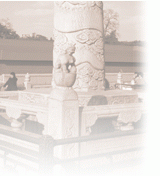 |
||||||

| ||||||
|
| ||||||
|
| ||||||
|
| ||||||
| начало > новини | |||
|
|
|||
|
| |||


